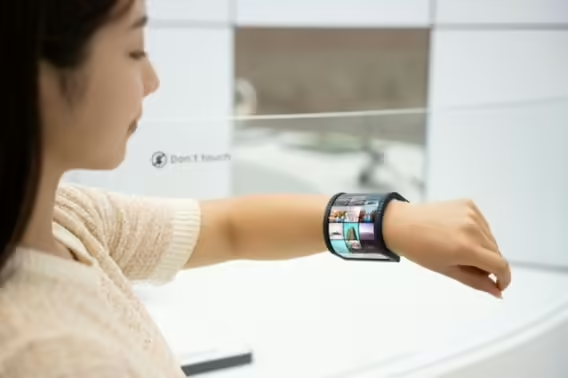K-Display 2024 is kicking off in Korea and its time for a round of backslapping, self-congratulatory local pride. For reasons that only marketing people may understand, every company seems to need a theme to announce itself. LG Display is here under the banner of “A Better Future” and Samsung Display is participating under the theme “Journey into AI: OLED Leaps.”
LG’s main standouts are 83-inch OLED TV panel featuring its META Technology 2.0, touted as improving screen brightness by 42% compared to the previous generation and achieving a maximum brightness of 3,000 nits.
The gaming lineup is pretty interesting with OLED taking center stage, but also a commitment to IPS Black monitors, and it Includes panels spanning 27, 31.5, 34, 39, and 45 inches. The 31.5-inch panel features the much vaunted dynamic frequency & resolution (DFR) technology, which lets you choose between high-refresh-rate (FHD@480Hz) and high-resolution (UHD@240Hz) modes. The 45-inch OLED has a maximum curvature of 800R (the same degree of curve as a circle with a radius of 800mm).
Automotive is where LG really differentiates itself. An 18-inch slidable OLED has gotten a lot of attention., sliding down when needed for use in the backseat. It seems to be targeted at people who sit in the backseat because they have drivers but still semes to try and appeal to people who have kids and want to shut them up on a long car ride. I am not sure how practical or pricey the solution is, but it certainly catches the eye.
Samsung Display is flexing its considerable muscle with over 40 product demos. The one that stands out is the multi-foldable OLEDs, the Flex In&Out with a 360 degree flex, the Flex S which folds twice inward and outward, and the Flex Hybrid combining foldable and slidable. Combined with an array of circular OLED, there’s certainly an emphasis on coming up with new ways in which display could be used to create new products.
Samsung is showing off myriad uses of round OLED displays in concepts for smart keys, smart headphones with 1.5-inch circular OLEDs, and a smartwatch band with a 6.2-inch flexible OLED, and a smart speaker with a 7.6-inch flexible OLED.

There’s also OLEDoS and Samsung has a new white OLEDoS with an industry-first ultra-high brightness of 12,000 nits in a 1.3-inch form factor, with a claimed 4000 ppi. Whatever the ultimate market opportunity for XR devices, Samsung certainly has a stake in delivering a compelling solultion especially if Apple continues to plan for future versions of its Vision Pro, looking for dependable supplies for lower cost versions.
And, there are the usual references to AI, but Samsung may have something going for it here that may impact display development; the company has developed applications of AI to image processing and photography that could lend some credence to its bigger flights of fancy in display design. The company is citing an example of creating drawings or AI images on a split screen, and using a three-part screen for activities like photo shoots, AI searches, and editing social media content.
Both LG and Samsung seem to be focused on findings ways to differentiate themselves with Chinese competitors in OLED, and the path to success seems to be in finding seams of opportunity in areas where their technology is well advanced and where the market is still nascent.
In fact, Samsung Display’s chairman, Choi Joo-sun, told a reporter from Korean newspaper Shin-A Ilbo that ultra-low power consumption and performance, is more important than sheer production numbers in reference to the growing market share of Chinese competitors. While cautious about the second half of the year’s performance, he emphasized that Samsung Display would still be competitive in terms of production volumes but that there was more to OLED than shipping in large volumes. He also expressed hope for Samsung’s abilities to commercialize MIcroLED.
K-Display 2024 is obviously a celebration of Korea’s display technology companies and it should come as no surprise that it is a showcase of the best and brightest developments, as well as a chance to take weird and wonderful ideas out for a ride, putting momentum behind the things that the Korean display industry can do better than its competitors. However, the underlying sense of needing to pull away in directions that would leave Chinese manufacturers behind has created a sense of urgency to pioneer new product channels.
For LG, the automotive market is still its biggest opportunity and a hedge against Chinese competitors, although not exclusively because of OLED. LG was also showing pillar-to-pillar IPS LCD consoles. For Samsung, foldables are proving to be a positioning statement and it helps that the company can take its best ideas and implement them in its own smartphones. The tie-in between its AI image processing software and foldable screen applications should keep the company ahead of the pack but there is a danger that by staying premium and on the bleeding edge, Samsung may feel the pinch from Chinese smartphone markers and foldable panel suppliers who stick to the basics and just keep making good enough, more affordable, more ubiquitous foldables. MicroLED and microdisplays will probably continue to be long-term plays with some concern as to their viability and their timelines to commercialization.
If there is anything that we can conclude from K-Display 2024 based on waht we are seeing from the big two in Korea it is that there a lot of bets being made right now and options being kept open but that an uncertain second quarter, and the realization of the threat of Chinese manufacturers will force Samsung and LG to make some hard decisions by the end of this year about how they will address the challegnes of the second half of the decade.

